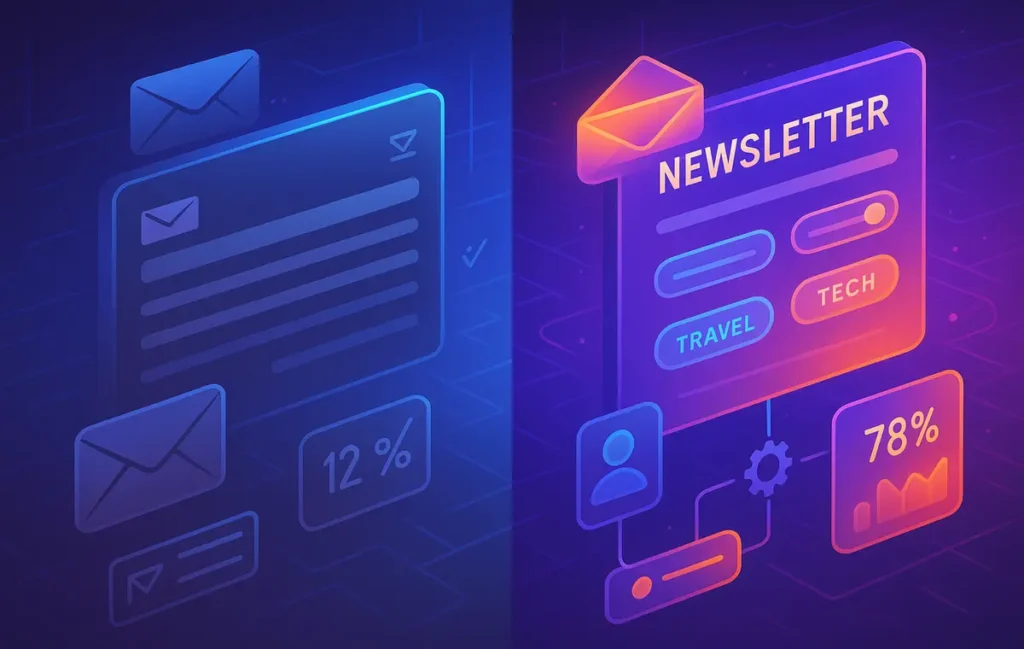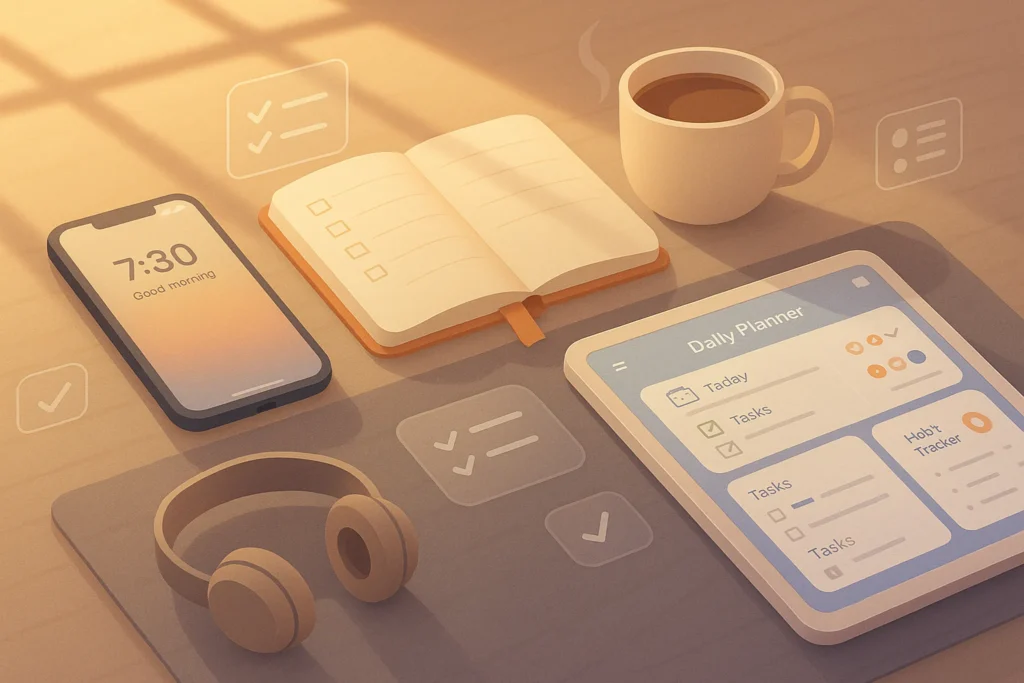🌟 Why Newsletters Still Matter (and Why Growth is Harder Now)
Despite the rise of social platforms and algorithm-driven feeds, newsletters remain one of the most powerful marketing channels. They land directly in a subscriber’s inbox, bypassing gatekeepers, and create a one-to-one relationship that no platform can replicate. Yet growing a newsletter today isn’t as simple as adding a “Subscribe” button to your blog. Audiences are more protective of their inboxes, and competition for attention is fierce.
The growth challenge is clear: generic sign-up forms and bland content don’t cut it anymore. To stand out, you need two ingredients that modern marketers are finally embracing—zero-party data and behavioral triggers. Together, they form a growth engine that doesn’t just add subscribers, but keeps them engaged and retained over the long haul.
💡 Nerd Tip: Growth isn’t about bigger lists—it’s about building the right list with people who actively want your content.
👉 “Most newsletters struggle because they rely only on organic sign-ups. But combining zero-party data with smart AI-powered growth hacks can accelerate list building dramatically. In fact, many creators now use workflows that tie quizzes, feedback loops, and AI-driven targeting together—a strategy we unpack in detail in our Ultimate Guide to Building an Email List with AI Tools.
🧠 Psychology of Sharing Data
Why do people willingly give their preferences, interests, or personal details when signing up for a newsletter? The psychology behind zero-party data collection comes down to three main factors. First is reciprocity: when someone receives something valuable—like a tailored resource, quiz result, or free toolkit—they feel more inclined to share something in return. Second is control: unlike data that’s inferred or tracked passively, zero-party data empowers subscribers to decide what to reveal. This sense of agency builds trust. Third is brand trust itself: if a brand like NerdChips is seen as transparent and value-driven, subscribers feel safe giving honest answers because they know the data won’t be misused.
💡 Nerd Tip: Always position your data requests as a way for the subscriber to get better, more personalized content—not as a way for you to extract information.
🔑 What is Zero-Party Data?
Zero-party data is information that a subscriber voluntarily shares with you. Unlike first-party data, which you infer from user behavior (like clicks or opens), zero-party data is explicit. It comes directly from the subscriber through quizzes, surveys, feedback forms, or preference centers.
For example, a newsletter might ask:
-
“Do you prefer weekly or bi-weekly emails?”
-
“Which topics interest you most: AI, marketing, or productivity?”
-
“What’s your biggest challenge in your role?”
This data is gold because it’s accurate, consent-driven, and tied to trust. When subscribers hand you their preferences, they expect you to use that information to improve their experience.
💡 Nerd Tip: Always frame data collection as a value exchange. Make it clear that by sharing preferences, subscribers will get more personalized, relevant content.
🚀 Why Zero-Party Data is a Game-Changer
Trust is the currency of newsletters. By asking people what they want, you prove that you’re listening. This strengthens loyalty and directly boosts performance metrics. Newsletters that leverage zero-party data typically see:
-
Higher open rates because content is tailored to subscriber interests.
-
Increased click-through rates because links match what subscribers care about.
-
Improved retention because readers feel in control of their experience.
One benchmark report revealed that brands using zero-party data for personalization saw a 20% lift in engagement compared to generic newsletters. This isn’t just about feel-good personalization; it’s about conversion and long-term ROI.
💡 Nerd Tip: Create a “preference center” in your newsletter signup process. Even two questions can dramatically improve targeting and engagement.
🎯 Trigger-Based Growth Tactics
Collecting data is only half the battle. The next step is activating it through triggers—automated actions based on behavior or context.
-
Welcome Sequences: Triggered immediately after sign-up, introducing your brand and building trust from day one.
-
Behavioral Triggers: Actions like clicking a link, opening consistently, or making a purchase can trigger tailored follow-ups. For example, if a subscriber clicks a link about “marketing automation,” they can be added to a segment receiving deeper automation content.
-
Contextual Triggers: These are based on time, location, or external events. Think “birthday emails,” “local event updates,” or “time-sensitive offers.”
Triggers are powerful because they meet subscribers where they are, rather than relying on one-size-fits-all blasts. Research shows that triggered emails have 3x higher engagement rates than batch campaigns.
💡 Nerd Tip: Start with a simple welcome trigger, then layer on complexity. Too many triggers at once can overwhelm both you and your subscribers.
👉 “The fear many marketers have is that advanced triggers require coding or complex setups. But modern platforms make it possible to design welcome flows, behavioral sequences, and contextual triggers in minutes. Our piece on Email Automation for Non-Techies explains how even beginners can set up automation frameworks that deliver personalized journeys without touching a single line of code.”
🛠️ Tools to Capture & Use Zero-Party Data
The right tools make collecting and activating data easier.
-
Typeform & Jotform: Great for quizzes, surveys, and feedback forms.
-
OptinMonster: Helps turn website visitors into subscribers with targeted pop-ups and forms.
-
Klaviyo & ConvertKit: Email platforms that support both preference centers and advanced triggers.
Each of these tools integrates well with CRMs and analytics platforms, ensuring zero-party data flows seamlessly into personalized campaigns.
💡 Nerd Tip: Always connect your data-capture tools to your email platform. Data that sits in silos doesn’t drive growth.
👉 “Collecting data is only half the equation—you also need an email platform robust enough to process that data into personalized campaigns. Some tools excel at preference-based segmentation, others at behavioral automation. Our breakdown of the 10 Best Email Marketing Tools shows which platforms strike the right balance between usability, analytics depth, and automation power.”
📈 Case Study: Growth Through Data & Triggers
A lifestyle brand with 50,000 subscribers wanted to increase engagement. Instead of blasting everyone with the same content, they introduced a quiz: “What’s Your Wellness Style?” The answers segmented subscribers into three groups—fitness, nutrition, and mindfulness.
Next, they layered triggers:
-
Fitness subscribers received workout challenges.
-
Nutrition subscribers got recipe bundles.
-
Mindfulness subscribers got guided meditations.
Within six months, open rates jumped from 22% to 37%, and click-through rates doubled. More importantly, unsubscribe rates dropped by half, proving that personalization and triggers build retention as much as growth.
🧩 Implementation Framework
To combine zero-party data and triggers effectively, follow this simple cycle:
-
Collect: Use quizzes, surveys, or preference forms to gather explicit subscriber data.
-
Organize: Store it in your email platform or CRM with clear tags and segments.
-
Trigger: Build automated workflows that respond to behaviors and preferences.
-
Measure: Track open rates, CTR, and retention by segment.
-
Iterate: Refine based on performance. Drop what doesn’t work and scale what does.
💡 Nerd Tip: Don’t wait for perfection. Even a single question plus a welcome sequence is better than generic blasts.
👉 “Iteration doesn’t always require big budgets. Some of the most effective growth systems start with lightweight, free tools that automate delivery, test timing, and measure engagement. Our review of the Best Free Tools to Automate Email Newsletters highlights options that give small teams the leverage of enterprise automation without upfront costs.”
⚠️ Challenges & Compliance
Collecting zero-party data comes with responsibility. GDPR and CCPA regulations require transparency about how subscriber data will be used. Every form should clearly state what subscribers are signing up for, and consent must be explicit.
Trust also extends to design. Overly aggressive pop-ups or vague privacy disclaimers can make your brand look spammy. Instead, use clean, transparent landing pages with clear language like, “We’ll only send one tip-packed email per week. Unsubscribe anytime.”
💡 Nerd Tip: Compliance isn’t just about avoiding fines—it builds the trust that keeps your subscribers loyal long-term.
⚡ Ready to Grow Your Newsletter Smarter?
Use tools like Typeform, OptinMonster, and Klaviyo to capture zero-party data and build trigger-based workflows. Your growth engine starts here.
📊 Comparison: Zero-Party vs. First-Party vs. Third-Party Data
To understand why zero-party data is so powerful, it helps to compare it directly with other types of customer data:
| Data Type | Definition | Example | Advantages | Risks |
|---|---|---|---|---|
| Zero-Party | Data willingly shared by the user | Quiz answers, preference centers | High accuracy, trust-based, consent-driven | Requires engagement to collect |
| First-Party | Data observed by your own systems | Opens, clicks, site behavior | Reliable, owned by you, compliant-friendly | Limited to actions taken |
| Third-Party | Data purchased or inferred externally | Data brokers, cookies | Broad reach, quick to scale | Low trust, regulatory risks, declining relevance |
This table shows why zero-party data stands out. It’s not just compliant—it’s future-proof, as third-party cookies phase out and consumers demand more transparency.
📈 Metrics to Track Newsletter Growth
Collecting zero-party data and using triggers is powerful, but only if you measure impact. The following KPIs give a full picture of newsletter health:
-
Growth Rate: The number of net new subscribers gained each month. Benchmarks vary, but aiming for steady double-digit monthly growth is ideal.
-
Engagement Rate: Track opens and CTR by segment. For instance, subscribers who chose “AI Tools” in a preference survey should show higher engagement when receiving AI-focused emails.
-
Retention & Churn: Unsubscribe rates show whether your personalization strategy is working. A drop in churn after implementing zero-party personalization is a strong success signal.
-
Conversion by Segment: Tie subscriber actions (like clicks on affiliate links or product trials) back to their declared preferences. This reveals which data-driven segments are most profitable.
💡 Nerd Tip: Don’t just measure vanity metrics like list size. Focus on retention and conversions—the true signs of newsletter growth.
🤖 AI in Zero-Party Data Activation
Collecting data is one thing. Activating it at scale is another. This is where AI transforms the game. AI-powered platforms can take zero-party inputs and instantly personalize content for each subscriber. For example, a subscriber who selects “Productivity Tools” in a quiz might automatically receive AI-curated articles and offers related to apps and workflows.
AI also helps with predictive segmentation. Instead of waiting for explicit input, AI models can suggest micro-segments based on a mix of zero-party and first-party data. Generative AI, such as GPT-driven copy engines, can dynamically adapt subject lines, CTAs, and even body text to resonate with each segment.
💡 Nerd Tip: Test AI-powered personalization on a small segment first—measure lift in CTR and retention before rolling out broadly.
👉 “The real breakthrough happens when AI layers sit on top of zero-party inputs. Instead of manually building dozens of segments, algorithms can predict which content resonates with each subscriber and adapt subject lines, CTAs, or even article order. We’ve explored this frontier in How to Use AI to Personalize Email Campaigns, showing how predictive models and generative tools create newsletters that feel tailor-made.”
🚀 Future Outlook: Micro-Newsletters & Dynamic Content
The future of newsletters is moving away from one-size-fits-all blasts toward hyper-personalized micro-experiences. Imagine two subscribers in the same newsletter list—but one gets a detailed breakdown of AI-powered marketing tools while the other receives case studies on newsletter automation. This future is already unfolding, driven by zero-party data and trigger-based automation.
We’re also seeing a rise in micro-lead magnets—short, sharp content pieces that capture preferences quickly and guide subscribers into specific content tracks. Combined with AI, this will lead to dynamic newsletters where each edition feels hand-crafted for the reader.
💡 Nerd Tip: Start building the foundations now. Even simple segmentation by interest area prepares your newsletter for the shift to dynamic, AI-personalized content.
📬 Want More Smart AI Tips Like This?
Join our free newsletter and get weekly insights on AI tools, no-code apps, and future tech—delivered straight to your inbox. No fluff. Just high-quality content for creators, founders, and future builders.
🔐 100% privacy. No noise. Just value-packed content tips from NerdChips.
🧠 Nerd Verdict
Zero-party data and behavioral triggers are the twin engines of newsletter growth in 2025. They transform a generic sign-up list into a living, segmented audience that feels heard, valued, and engaged. Instead of chasing vanity metrics, you build a newsletter that people actually look forward to opening.
At NerdChips, we see this as the future of email marketing: a blend of trust, personalization, and smart automation that grows not just your list, but your relationship with every subscriber.
❓ Nerds Ask, We Answer
💬 Would You Bite?
If your subscribers told you exactly what they wanted to read, would you change your newsletter strategy—or keep sending what you think works?
Crafted by NerdChips for creators and marketers building newsletters people love to open.



